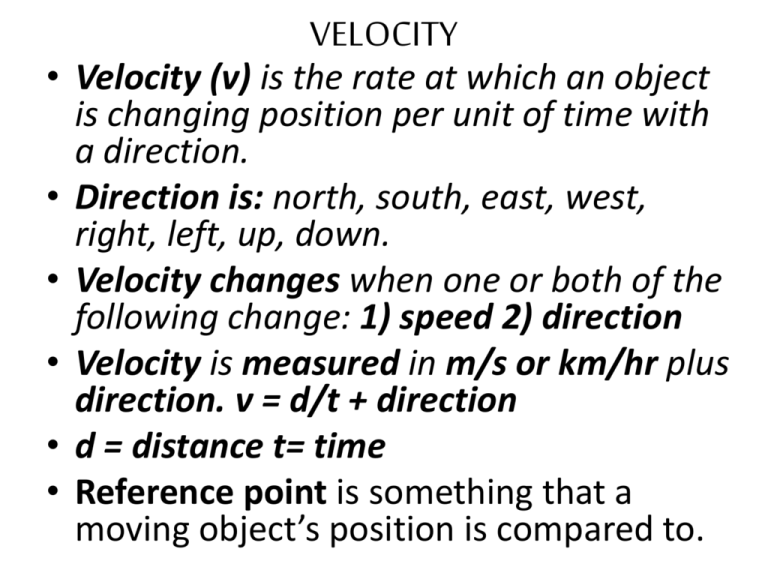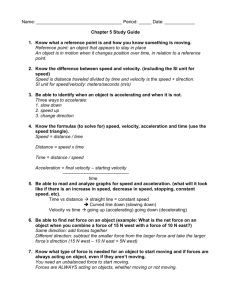PhysicsAssessment_1
advertisement

VELOCITY • Velocity (v) is the rate at which an object is changing position per unit of time with a direction. • Direction is: north, south, east, west, right, left, up, down. • Velocity changes when one or both of the following change: 1) speed 2) direction • Velocity is measured in m/s or km/hr plus direction. v = d/t + direction • d = distance t= time • Reference point is something that a moving object’s position is compared to. VELOCITY Questions 1.What is the velocity of a car determined by? 2.When a vehicle starts moving at a faster rate, what happens to the velocity of the vehicle? 3.Traveling down a straight highway, a car changed velocity while its speed remained constant. What most likely caused this to happen? VELOCITY Questions 4. In which example can velocity be determined? A. A truck drives 50 km/hr B. A boat sails southeast at 20km/hr C. A train travels northwest for 30 km D. A plane flies 80 km VELOCITY Answers 1. Speed and direction 2. The velocity changes because the speed changed 3. The car changed direction 4. B. A boat sails southeast at 20km/hr BALANCED & UNBALANCED FORCES • Balanced forces are equal forces acting on an object from different directions that keep the object stationary (not moving). • Forces have magnitude (size) and direction (arrow). • Forces are measured in Newtons. • The Newton is a unit that measures force and weight in the metric system BALANCED & UNBALANCED FORCES • 1. The arrows in the diagrams show the forces applied to a stationary orange. In which diagram will the orange remain stationary? • A B C D BALANCED & UNBALANCED FORCES 2. The picture shows the forces acting on a ball. In which of the pictures will the ball remain motionless? A B C D BALANCED & UNBALANCED FORCES 3. Forces applied to a box below are indicated with arrows. In which of the diagrams the box is in motion (moving)? A B C D FORCE—GRAVITY • Force is a push or a pull • Force is measured in Newtons (N) • Force has magnitude (a number) and direction (arrow) FORCE—GRAVITY 1. The picture shows a snail traveling up a hill. Which arrow in the diagram represents the force of gravity acting on the snail? FORCES—FRICTION • Friction is a type of force that opposes motion. This means that friction goes against motion and slows down the moving object. If a surface is rough, there is more friction. • If the surface is smooth, there is less friction and you move faster. • When an object is stationary (motionless) on a surface, the surface is exerting an upward force which is equal to the force of gravity. • This results in balanced forces so the object does not move or fall. FORCES—FRICTION Example: A vase on a table • The table exerts a force of friction that is upward and equal to the force of gravity. • The vase does not fall. • If you put a vase on a sheet of paper, it will fall because the force of gravity is stronger than the friction exerted by the paper. gravity • This results in unbalanced forces and the vase falls. friction AIR RESISTANCE • AIR RESISTANCE is a force exerted by air paper air resistance FORCE 1. Force is a push or a pull. Force has direction. When you ride your bike, a forward force is applied on the pedal. Other forces act in the opposite direction of the bicycle’s forward motion. Which of the following combination of forces act in the opposite direction? A friction and gravity B air resistance and gravity C air resistance and friction D gravity, air resistance, and friction FORCE Answer C -- air resistance and friction FORCE 2. A rock is resting motionless on a hill. What is creating the force that is acting in the direction of the arrow? A gravity B friction C the hill D the rock FORCE Answer C-- The hill FORCE 3. Devon placed a cup of soda at the top of an inclined wooden board. The cup remained where he placed it. Why did the cup stay at the top of the board? A. The mass of the cup of soda was reduced by the force of friction. B. The force of friction equaled the force pulling the cup of soda down the board. C. The board decreased the amount of gravity acting on the cup of soda. D. The force of friction was greater than the force pulling the cup of soda down the board. FORCE Answer #3 B --The force of friction equaled the force pulling the cup of soda down the board. FORCE 4. If you release a block of wood and a block of ice at the same time from the top of a slide, the ice block reaches the bottom of the slide first. Why did the wood reach the bottom last? A. There was more friction on the wood B. There was less friction on the wood C. The force of gravity was stronger on the wood than on the ice. D. The force of gravity was stronger on the ice than on the wood. FORCE Answer #4 A. There was more friction on the wood. FORCE 5. The glass resting on a table is stationary. Why? FORCE Answer #5 The table is exerting an upward force that opposes gravity. CENTRIPETAL FORCE • Centripetal force is the force that pushes a moving body toward the centre or • a force which keeps a body moving with a uniform speed along a circular path and is directed towards the centre. QUESTIONS 1. A car is traveling around a corner at a constant speed. Which diagram shows the direction of the centripetal force that results in the change of velocity? CENTRIPETAL FORCE CENTRIPETAL FORCE Answer #1 C BUOYANT FORCE • Buoyant Force has an upward direction and a magnitude equal to the weight of the water (or liquid) displaced by a floating object. Example: a cork or a boat floating in the water is pushed upward by a force called buoyant force that is equal to the weight of the water that the boat or the cork is displacing. BUOYANT FORCE 1. What is the direction and size of the buoyant force acting on a boat or a cork floating in water? BUOYANT FORCE Answer #1 Upward and equal to the weight of the water displaced by the boat/cork. BUOYANT FORCE 2. The arrows in the picture show the direction and magnitude of four forces acting on a boat. What determines the magnitude of the force shown by arrow X? A. The total volume of the boat B. The size of the lake C. The weight of the water displaced by the boat D. The total mass of the person in the canoe BUOYANT FORCE BUOYANT FORCE Answer #2 C. The weight of the water displaced by the boat





